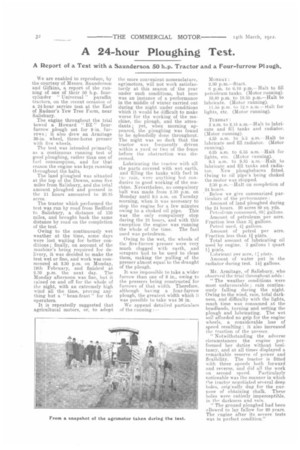A 24-hour Ploughing Test.
Page 12

If you've noticed an error in this article please click here to report it so we can fix it.
A Report of a Test with a Saunderson 50 hp. Tractor and a Four-furrow Plough.
We are enabled to reproduce, by the courtesy of Messrs. Sa.underson and Gifkins, a report of the running of one of their 50 h.p. fourcylinder " Universal" paraffin tractors, on the recent occasion of a 24-hour service test at the Earl of Radnor's Yew Tree Farm, near Salisbury.
The engine throughout the trial towed a Howard " BZ " fourfurrow plough set for 9-in. furrows ; it also drew an Armitage 36-in, wheel, three-horse presser with five wheels.
The test was intended primarily as a continuous running test of good ploughing, rather than one of fuel consumption, and for that reason the engine was kept running throughout the halts.
The land ploughed was situated at the top of the Downs, some five miles from Salisbury, and the total amount ploughed and pressed in the 21 hours amounted to 20.85 acres.
The tractor which performed the test was run by road from Bedford to Salisbury, a distance of 130 miles, and brought back the same distance by road on the completion of the test.
Owing to the continuously wet weather at the time, some days were lost waiting for better conditions; finally, on account of the machine's being required for delivery, it was decided to make the test wet or fine, and work was commenced at 2.30 p.m. on Monday, 19th February, and finished at 2.30 p.m. the next day. The Monday afternoon was fine, but it rained on and off for the whole of the night, with an extremely high wind all the time, proving anything but a "bean-feast" for the operators.
It is repeatedly suggested that agricultural motors, or, to adopt
the more convenient nomenclature, agrimotors, will not work satisfactorily at this season of the year under such conditions, but here was an instance of a performance in the middle of winter carried out during the night under conditions which it would be difficult to make worse for the working of the machine, the plough, and the attendants; yet, when morning appeared, the ploughing was found to be splendidly done throughout. The night was so dark that the tractor was frequently driven within a yard or two of the fence before the obstruction was discerned.
Lubricating the tractor with all the parts covered with wet earth, and filling the tanks with fuel in the rain, were anything but conducive to good working of the machine. Nevertheless, no compulsory halt was made from 2.30 p.m. on Monday until 9.5 a.m. on Tuesday morning, when it. was necessary to stop the engine for a few minutes owing to a choked oil pipe. This was the only compulsory stop during the 24 hours, and with this exception the engine was running the whole of the time. The fuel used was petroleum.
Owing to the wet, the wheels of the five-furrow presser were very much clogged with earth, and scrapers had to be used to clean them, making the pulling of the presser almost equal to the draught of the plough.
It was impossible to take a.wider furrow than one of 9 in., owing to the pressers being constructed for furrows of that width. Therefore, although having a four-furrow plough, the greatest width which it was possible to take was 36 in.
We append detailed particulars of the running:—
MONDAY: 2.30 p.m.—Start.
6 p.m. to 6.10 p.m.—Halt to fill petroleum tanks. (Motor running). 10.40 p.m. to 10.55 p.m.—Halt to lubricate. (Motor running). I p.m. to 12.8 a.m.—tlalt for lights, etc. (Motor running).
TUESDAY:
2 a.m. to 2.15 a.m.—Halt to lubricate and fill tanks and radiator. (Motor running). 4.53 a.m. to 3.5 a.m.—Halt to lubricate and fill radiator. (Motor running). 6.25 a.m. to 6.35 a.m.—Halt for lights, etc. (Motor running). 9.5 a.m. to 9.35 a.m.—Halt to lubricate and fill tanks and radiator. New ploughshares fitted. Owing to oil pipe's being choked the motor was stopped.
2.30 p.m.—Halt on completion of 24 hours.
' Below we give summarized particulars of the performance : Amount of land ploughed during the 24 hours. 20 acres 89 sq. yds. Petroleum consumed, 69!. gallons. Amount of petroleum per acre. Fraction less than 34 gallons. Petrol used. 4+ gallons.
Amount of petrolper acre. Fraction less than l pints.
Total amount of lubricating oil used by engine. 3 gallons 1 quart ii pints.
Lubricant per acre, I pints. Amount of water put in the radiator during test. 141t gallons.
Mr. Armitage, of Salisbury, who observed the trial throughout adds : "The weather conditions were most unfavourable ; rain continuously falling during the night. Owing to the wind, rain, total darkness, and difficulty with the lights, much time was consumed at the headlands, turning and setting the plough and lubricating. The wet soil afforded no grip for the. engine wheels, a considerable loss of speed resulting ; it also increased the traction of the presser.
"Notwithstanding the adverse circumstances the engine performed her duties without hesitancy, and at all times displayed a remarkable reserve of power and flexibility. The tractor is fitted with three speeds both rd and reverse, and did all the work on second speed. Particularly noticeable was the manner in which the tractor negotiated several deep holes, orig -rrally dug for the purpose of obtaining chalk. These holes were entirely imperceptible, in the darkness and rain, "The ground ploughed had been allowed to lay fallow for 20 years. The engine after its severe tests was in perfect condition."
























